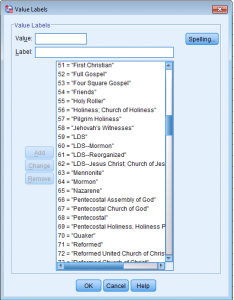The General Social Survey (GSS) is a long-running, mostly cross-sectional survey of the non-institutionalized adult population in the US (since 1972). Since the beginning, the GSS has asked people about their religious affiliations. While Mormons make up only a very small percentage of the US population (between 1% and 2%), there are enough in the combined GSS (1972-2014) to aggregate them across waves and analyze them (though, of course, there are problems with doing so). In this post, I’m going to show you how to isolate Mormons for analysis in the GSS.
- Download the combined waves of the GSS from one of the many GSS repositories (from the GSS website, the ARDA has it, as do other sites).
- Second, once you have it downloaded, open it in your preferred data analysis package (I’ll be using SPSS, but you can use whichever one you prefer).
- Third, find the variable “other,” which is typically located (depending on the organization of the data set) right after “relig” and “denom.”
- The variable “other” has codes for specific Protestant denominations. As you scroll through the various options, you’ll see that there are five options for Mormon: 59=LDS, 60=LDS–Mormon, 61=LDS–Reorganized, 62=LDS–Jesus Christ, Church of Jesus LDS, and 64=Mormon.

If the goal is to analyze members of The Church of Jesus Christ of Latter-day Saints (the group headquartered in SLC), you want just one of these: 64. The other three that you think you would want, 59, 60, and 62, used to be used for SLC Mormons, but as of a few years ago, the GSS folks moved all of these individuals into code 64. So, now, you just need 64. - Once you’ve located the variable, it’s now time to recode the data. Using the recode function of your software package (in SPSS it’s “Transform” -> “Recode into Different Variables”). I generally just create one new variable that I label “Mormon” and dummy code it so those who are Mormon are a “1” and those who are not are a “0”. My recode looks like this:
- Just to check your recode, you can run frequencies on this new variable after you’re done and, if you’re using the 1972-2014 combined GSS, you should find 714 Mormons and 58,885 non-Mormons in the GSS after the recode. That’s not a ton of Mormons, but it’s enough to run analyses on them.
(NOTE: Because people have changed a lot over time, it’s pretty common to break up the Mormons in the GSS into decade groups (e.g., 1972-1979, 1980-1989, 1990-1999, and 2000-2014). That shrinks the numbers of Mormons even further, but it likely makes for a more accurate analysis. The number of Mormon participants in any given year ranges from a low of 6 in 1973 to a high of 70 in 2006.)